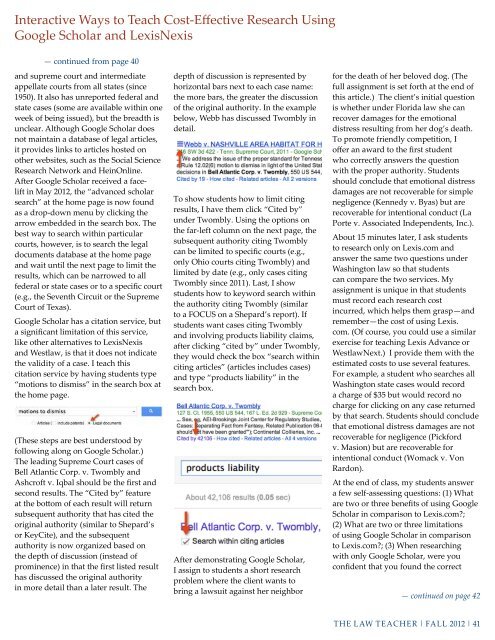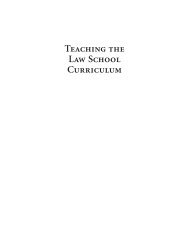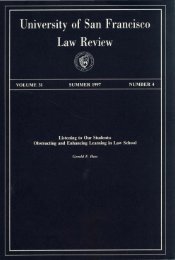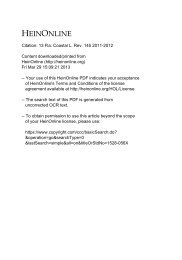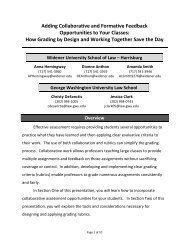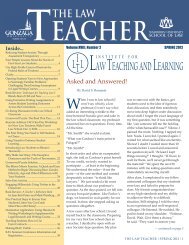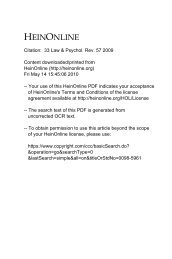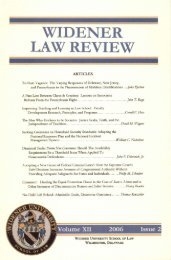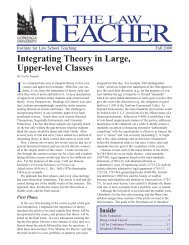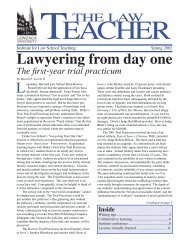The Law Teacher - Institute for Law Teaching and Learning
The Law Teacher - Institute for Law Teaching and Learning
The Law Teacher - Institute for Law Teaching and Learning
Create successful ePaper yourself
Turn your PDF publications into a flip-book with our unique Google optimized e-Paper software.
Interactive Ways to Teach Cost-Effective Research Using<br />
Google Scholar <strong>and</strong> LexisNexis<br />
— continued from page 40<br />
<strong>and</strong> supreme court <strong>and</strong> intermediate<br />
appellate courts from all states (since<br />
1950). It also has unreported federal <strong>and</strong><br />
state cases (some are available within one<br />
week of being issued), but the breadth is<br />
unclear. although Google Scholar does<br />
not maintain a database of legal articles,<br />
it provides links to articles hosted on<br />
other websites, such as the Social Science<br />
research Network <strong>and</strong> heinOnline.<br />
after Google Scholar received a facelift<br />
in May 2012, the “advanced scholar<br />
search” at the home page is now found<br />
as a drop-down menu by clicking the<br />
arrow embedded in the search box. <strong>The</strong><br />
best way to search within particular<br />
courts, however, is to search the legal<br />
documents database at the home page<br />
<strong>and</strong> wait until the next page to limit the<br />
results, which can be narrowed to all<br />
federal or state cases or to a specific court<br />
(e.g., the Seventh circuit or the Supreme<br />
court of Texas).<br />
Google Scholar has a citation service, but<br />
a significant limitation of this service,<br />
like other alternatives to LexisNexis<br />
<strong>and</strong> westlaw, is that it does not indicate<br />
the validity of a case. I teach this<br />
citation service by having students type<br />
“motions to dismiss” in the search box at<br />
the home page.<br />
(<strong>The</strong>se steps are best understood by<br />
following along on Google Scholar.)<br />
<strong>The</strong> leading Supreme court cases of<br />
Bell atlantic corp. v. Twombly <strong>and</strong><br />
Ashcroft v. Iqbal should be the first <strong>and</strong><br />
second results. <strong>The</strong> “cited by” feature<br />
at the bottom of each result will return<br />
subsequent authority that has cited the<br />
original authority (similar to Shepard’s<br />
or Keycite), <strong>and</strong> the subsequent<br />
authority is now organized based on<br />
the depth of discussion (instead of<br />
prominence) in that the first listed result<br />
has discussed the original authority<br />
in more detail than a later result. <strong>The</strong><br />
depth of discussion is represented by<br />
horizontal bars next to each case name:<br />
the more bars, the greater the discussion<br />
of the original authority. In the example<br />
below, webb has discussed Twombly in<br />
detail.<br />
To show students how to limit citing<br />
results, I have them click “cited by”<br />
under Twombly. Using the options on<br />
the far-left column on the next page, the<br />
subsequent authority citing Twombly<br />
can be limited to specific courts (e.g.,<br />
only Ohio courts citing Twombly) <strong>and</strong><br />
limited by date (e.g., only cases citing<br />
Twombly since 2011). Last, I show<br />
students how to keyword search within<br />
the authority citing Twombly (similar<br />
to a FOcUS on a Shepard’s report). If<br />
students want cases citing Twombly<br />
<strong>and</strong> involving products liability claims,<br />
after clicking “cited by” under Twombly,<br />
they would check the box “search within<br />
citing articles” (articles includes cases)<br />
<strong>and</strong> type “products liability” in the<br />
search box.<br />
after demonstrating Google Scholar,<br />
I assign to students a short research<br />
problem where the client wants to<br />
bring a lawsuit against her neighbor<br />
<strong>for</strong> the death of her beloved dog. (<strong>The</strong><br />
full assignment is set <strong>for</strong>th at the end of<br />
this article.) <strong>The</strong> client’s initial question<br />
is whether under Florida law she can<br />
recover damages <strong>for</strong> the emotional<br />
distress resulting from her dog’s death.<br />
To promote friendly competition, I<br />
offer an award to the first student<br />
who correctly answers the question<br />
with the proper authority. Students<br />
should conclude that emotional distress<br />
damages are not recoverable <strong>for</strong> simple<br />
negligence (Kennedy v. Byas) but are<br />
recoverable <strong>for</strong> intentional conduct (La<br />
Porte v. associated Independents, Inc.).<br />
about 15 minutes later, I ask students<br />
to research only on Lexis.com <strong>and</strong><br />
answer the same two questions under<br />
washington law so that students<br />
can compare the two services. My<br />
assignment is unique in that students<br />
must record each research cost<br />
incurred, which helps them grasp—<strong>and</strong><br />
remember—the cost of using Lexis.<br />
com. (Of course, you could use a similar<br />
exercise <strong>for</strong> teaching Lexis advance or<br />
westlawNext.) I provide them with the<br />
estimated costs to use several features.<br />
For example, a student who searches all<br />
washington state cases would record<br />
a charge of $35 but would record no<br />
charge <strong>for</strong> clicking on any case returned<br />
by that search. Students should conclude<br />
that emotional distress damages are not<br />
recoverable <strong>for</strong> negligence (Pick<strong>for</strong>d<br />
v. Masion) but are recoverable <strong>for</strong><br />
intentional conduct (womack v. Von<br />
rardon).<br />
at the end of class, my students answer<br />
a few self-assessing questions: (1) what<br />
are two or three benefits of using Google<br />
Scholar in comparison to Lexis.com?;<br />
(2) what are two or three limitations<br />
of using Google Scholar in comparison<br />
to Lexis.com?; (3) when researching<br />
with only Google Scholar, were you<br />
confident that you found the correct<br />
— continued on page 42<br />
<strong>The</strong> <strong>Law</strong> <strong>Teacher</strong> | FaLL 2012 | 41


